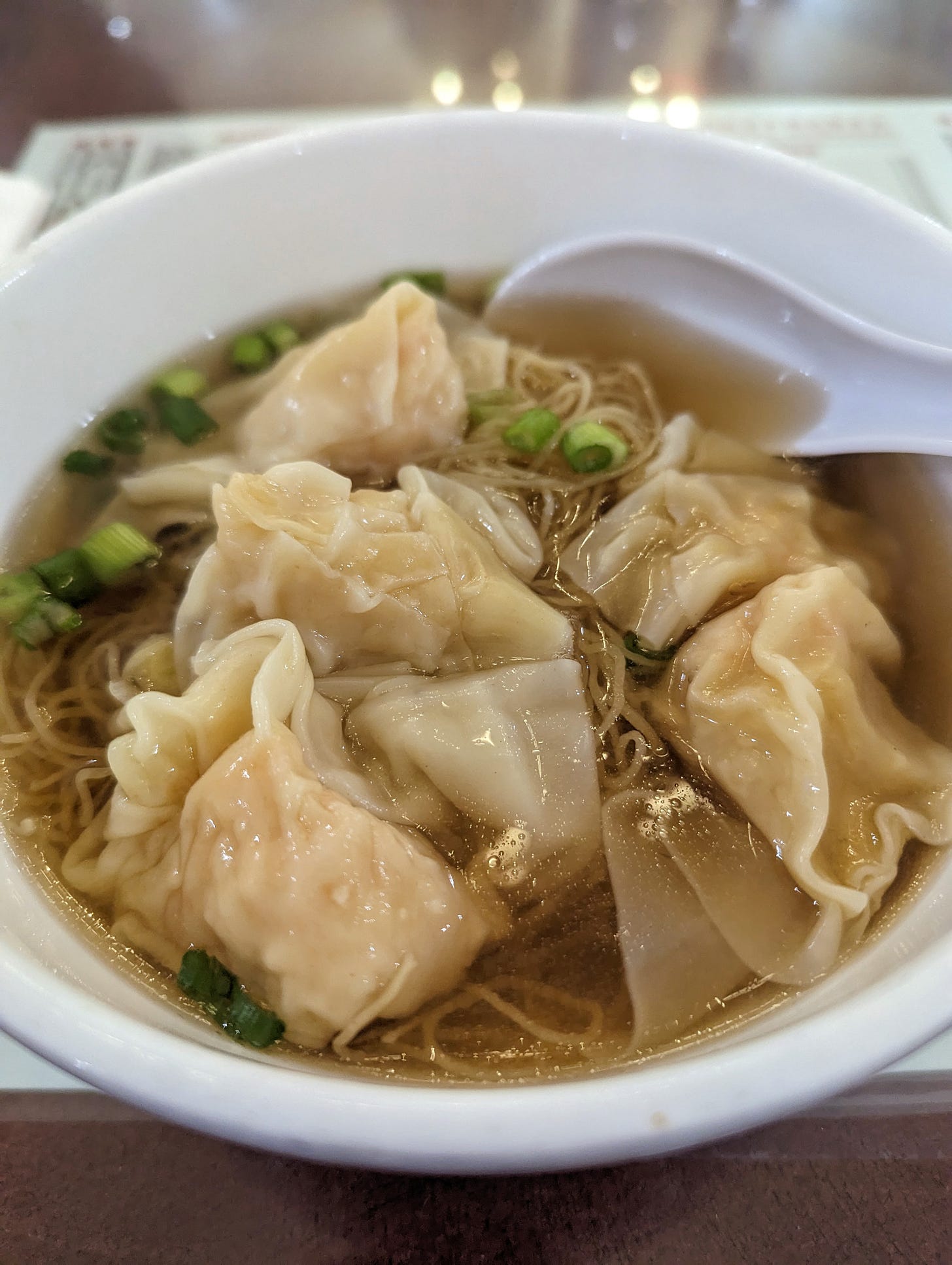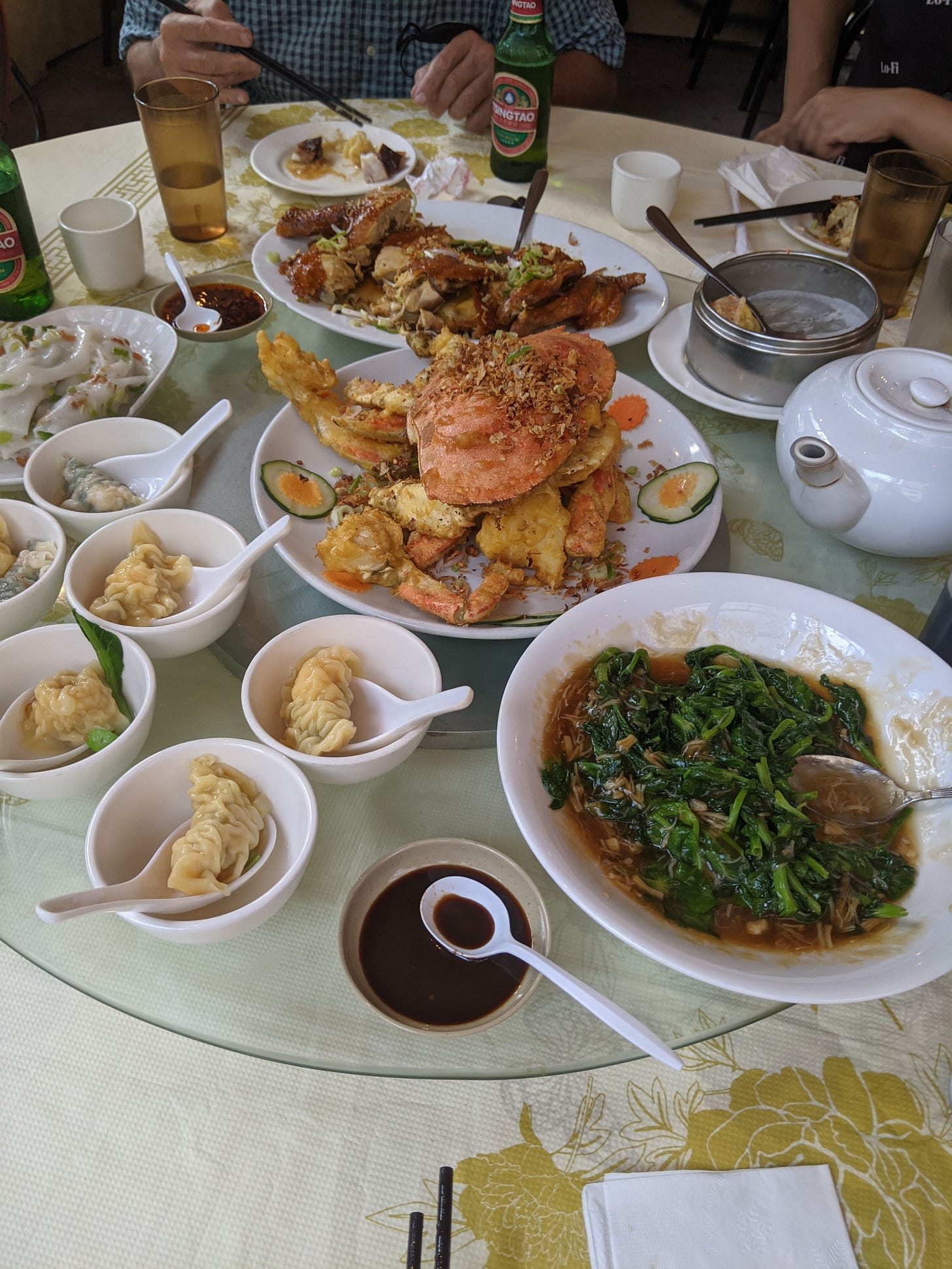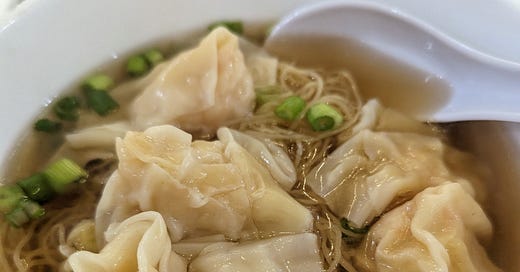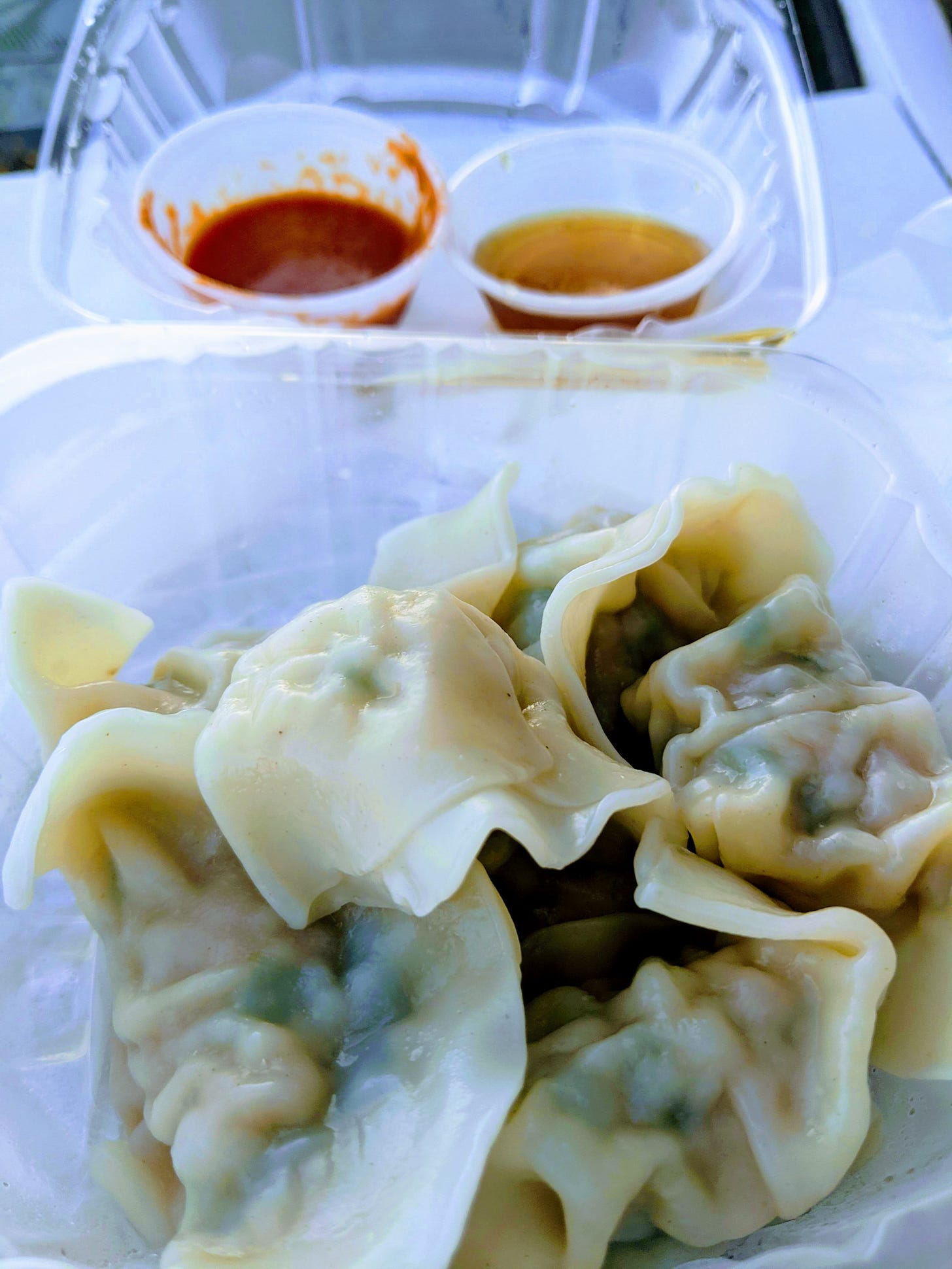The political-economy of Chinese dumplings or why the cheapest foods are often the tastiest
I lead food tours around New York City. On a recent tour, I was asked a simple question. Why might the same dish — a sandwich, a slice of pizza, a plate of dumplings — be three of four times as expensive in one restaurant than another restaurant a block or two away?
The question came up in Manhattan’s historic Chinatown while we ate pork and chive, chicken and mushroom, and pork and cabbage dumplings. Everyone agreed they were superb. The skins were silky and gently chewy, the fillings juicy, well seasoned, and packed with aromatics like chives and ginger. And they avoided the three fatal flaws of dumplings: Thick and doughy wrappers, torn skins, and opening up when boiled. All signs of poor craftsmanship.
The restaurant was bare bones and dingy. One person said, “I would normally never go into a place like this. How can the food be so good in such a dump like this?”
The spot, a Fujianese joint on Grand Street near Eldridge, sells six dumplings for $3. If you cross Houston Street, there are lots of restaurants serving dumplings. But six dumplings will cost you $10 or $15, and they won’t be as tasty as what we ate.
The reason for this divergence in price and quality comes to down to how migration, labor and immigration laws, supply chains, and culture all interrelate.
In a city like New York, historical patterns repeat, such as with immigration. Since the 19th century, wave after wave of immigrants has landed in Manhattan. More than 1 million Germans settled downtown during the 1800s, earning it the nickname of Kleindeutschland. Two million Irish immigrants, mostly in the mid-19th century, left Ireland as a result of the British-created famine. Many lived in Five Points, known as “the world’s most notorious slum,” and which was next to the Manhattan Chinatown. (New York City is so vast there are nine distinct Chinatowns.) Later that century, more than 1 million Italian peasants fled poverty for dreams of a better life in America and passed through New York. From 1880 to 1920, about 1.5 million Jews from East Europe, Ukraine, and Russia who escaped poverty and pogroms arrived in the Lower East Side. Still more communities came after World War I: the “Great Migration” of African-Americans from the South, Puerto Ricans granted U.S. citizenship as a result of the Jones Act in 1917, and new communities from Asia, Africa, and the Americas when nativist immigration laws were relaxed in 1965.
The pattern of immigration continues up to the present. In the last 30 years, some 1 million Fujianese have made a new home in New York City. Fujian is a mountainous province on the East Coast of China across from Taiwan, with extensive cultural diversity. In the 1980s, farmers had an average per capita income of $250 and factory workers perhaps $500. At the time many Fujianese were said to be illiterate, and they spoke numerous languages and dialects not understood in the rest of China. Supposedly most Fujianese speak Mandarin now. Nonetheless, economic migrants coming in search of a better life tend to be poorer. Most are undocumented. In Sunset Park, the largest Fujianese community in the city, many residents will eye outsiders suspiciously if they are lurking around or taking photographs.
Fujianese migrants can pay $35,000 to be smuggled to the U.S. Once here they are essentially indentured servants with huge debts to pay off. While some jobs exist in the remaining garment industry, many women work as maids in hotels, as home healthcare aides, or are pushed into sex work. For men, the restaurant industry is a significant source of employment as it is easier for them to stay in the shadows when they are in their own community and paid under the table.
This is the background to the $3 dumplings.
The influx of Fujianese immigrants was a boon for restaurant owners. The large workforce is criminalized and easily exploited. Needing to pay off huge debts, migrants take whatever jobs they can get, working hard and long for low wages.
In Chinatown, you can see cooks in open kitchens working intensely. Because owners can pick from a large pool of employees, there is a type of natural selection going on. The fastest and most skilled workers get jobs. My experience cooking professionally in New York City was that immigrants work harder and faster than nearly all the middle-class American kids inspired by Anthony Bourdain to pick up a knife and tongs.

But not everything was milk and honey for restaurant owners. The Chinese restaurant industry became hyper-competitive, and owners cut costs to the bone to survive.
One way to survive and even thrive is volume. It’s the Walmart model. Profits are razor thin at $3 for six dumplings, but huge volume adds up to huge profits. At the Fujianese restaurant, I recently watched an employee pull bags with 200 or so dumplings out of a dumbwaiter and lug five bags to the back kitchen. Plus she had a five-gallon bucket of pork-and-chive filling. That was enough for 1,200 dumplings or more. They might sell 10,000 dumplings in a busy Saturday. They also sell bags of 50 frozen dumplings to customers. In a year they could make and sell millions of dumplings. In effect, it’s a dumpling factory disguised as a cafeteria.
Unlike the crap sold at Walmart, the dumplings are excellent. The reason they do such a high volume — there are many other dumpling shacks in surrounding blocks not nearly as good — is the low cost and high quality. High volume is also self-reinforcing. The cooks become extraordinarily skilled and fast making that many dumplings day after day.
A hipster restaurant would probably struggle to make and sell 500 dumplings in a day, which is a significant reason their prices are much higher and quality lower.
But this social process of high-quality low-cost food can be undone by greed. One notorious example is Vanessa’s Dumplings. It used to be the reigning champion of cheap but delicious dumplings in Chinatown. About 20 years ago it earned acclaim from The New York Times, Village Voice, and Eater. New York Magazine still calls it “hands down” one of the best deals in Chinatown. But Vanessa expanded to eight locations around the city. The food at its premier location on Eldridge Street has suffered and costs have gone up. It is now about 60 percent more expensive than the Fujianese restaurant, and the dumplings are doughy and dull.
A crucial reason why cheap food can be so tasty is working-class immigrant culture. Unlike Little Italy, a Disneyfied tourist trap devoid of Italian-Americans, Chinatown is a living community. About 50,000 to 100,000 Chinese-Americans live there, and most are low-wage workers. The scores of dumpling spots, noodle huts, and Chinese bakeries serve as canteens for workers. Foods are made from low-cost industrialized farm commodities — flour, sugar, pork, chicken, oil, salt, cabbage — and served in bare-bones cafeterias by low-wage workers. They provide a fast, tasty, and cheap way for industrial proletariats to socially reproduce themselves. If you just finished a long shift, you can pop into a shabby eatery, order a mound of fatty, meaty, carb-heavy food that’s tasty, costs five to ten bucks, fills you up, and be finished in under 30 minutes. It’s food ideally suited for the spatial and temporal conditions of urban workers.

Like the late 1800s, many immigrants live in crowded tenements. In one Chinatown apartment, I counted six bunkbeds or 12 beds in one bedroom — and next door was a brothel. It is simpler to eat out than cook at home. Low-cost cafeterias and street foods are an ancient innovation. There are clues that streetside eateries catering to urban residents go back 5,000 years to Ancient Babylon. By Ancient Rome, street food was a major source of sustenance for the urban poor. In Pompeii, some 150 public cafeterias have been identified.
In dense immigrant communities, of which there are hundreds if not thousands around New York City, the quality of food and cooking skill varies widely. If you grew up eating a distinct cuisine, you are an expert in how it should taste and be eaten. So this further selects for quality.
Genuine cuisine requires both skilled cooks and knowledgeable eaters. In a city like Portland, Oregon, the whitest big city in America, a lot of the “ethnic food” is expensive and mediocre because it is made by white people who have no idea of how the food should really taste or be prepared.
In immigrant cities like L.A., Chicago, Houston, and New York, it’s completely different. There is plenty of bad and mediocre immigrant food, but it’s cheap. Among the many exceptional immigrant restaurants where the food is tasty, even spectacular, they are also cheap. Immigrants are not going to shell out a lot of money for food they grew up with, but they will flock to the best restaurants.
If you spent 12 hours hunched over a sewing machine, nailing drywall, or driving a taxi, you would look forward to a hot delicious meal as a daily reward. So immigrant restaurants that can compete on taste with other restaurants around them will be the most successful.
Jonathan Gold, the late L.A. food writer who is the only restaurant critic to win a Pulitzer Prize, had a rule how to locate the best immigrant food. He said, the exceptional restaurants are invariably the furthest out from the city center and the hardest to get to and find.
Gold hit the nail on the head, but never explained the principle. I will. The further you get from a downtown, the fewer tourists. In L.A. or New York, it can take an hour or two to visit some of the best restaurants. They are in dense communities where migrants huddle because the cost of living is cheap and they have familiar support networks. Because the restaurants draw cooks and customers exclusively from their own community, they are likeliest to excel. Often they are based on famous restaurants in the home country. Because food is a powerful connection to one’s homeland and culture and sense of self, those restaurants with the best food are likely to be the most successful.

One example of the Gold Rule is Sunset Park. As good as the food is in Lower Manhattan, restaurants in Sunset Park are even better. The exceptional Chinese, Vietnamese, Mexican, Malaysian, and Salvadorean restaurants are filled with members of their own community. The collective experience and knowledge raises the bar. Other examples are Jackson Heights and Flushing in Queens.
I grew up eating Punjabi food every day. I know hundreds of dishes intimately, and how they should look, smell, and taste. I know how to make them, the proper ingredients to use, and how they should be served and eaten. I can tell poor imitations with a glance or a whiff. Multiply my experience by thousands of people, and that explains why restaurants rooted in immigrant communities will consistently be far better than expensive knockoffs in touristy downtowns.
The next time you want to get delicious immigrant food, go to the source.





